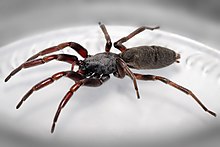White-tailed spider
| White-tailed spider | |
|---|---|
 |
|
| Adult | |
| Scientific classification | |
| Kingdom: | Animalia |
| Phylum: | Arthropoda |
| Subphylum: | Chelicerata |
| Class: | Arachnida |
| Order: | Araneae |
| Suborder: | Araneomorphae |
| Family: | Lamponidae |
| Genus: | Lampona |
| Species: | L. cylindrata L. murina |
| Binomial name | |
|
Lampona cylindrata L. Koch, 1866 |
|
|
Lampona murina L. Koch, 1873 |
|
White-tailed spiders are spiders native to southern and eastern Australia, and so named because of the whitish tips at the end of their abdomens. Body size is up to 18 mm, with leg-span of 28 mm. Common species are Lampona cylindrata and Lampona murina. Both these species have been introduced to New Zealand.
White-tailed spiders are vagrant hunters that seek out and envenom prey rather than spinning a web to capture it; their preferred prey is other spiders.
They are reported to bite humans; effects include local pain, a red mark, local swelling and itchiness; rarely nausea, vomiting, malaise or headache may occur. Ulcers and necrosis have been attributed to the bites, but a scientific study by Isbister and Gray (2003) showed these had other causes, mostly infections. A study of 130 white-tailed spider bites found no necrotic ulcers or confirmed infections.
Ludwig Carl Christian Koch described Lampona cylindrata in 1866 and Lampona murina in 1873. The genus name comes from the Latin lampo ("to shine"). The species name cylindrata refers to the cylindric body shape, while murinus means "mouse-gray" in Latin.
The two common species of white-tailed spiders are Lampona cylindrata and Lampona murina. They are similar in appearance; L. cylindrata is slightly larger with females being up to 18 mm long while males are up to 12 mm in body length. The legs span approximately 28 mm. The two species are not easily distinguished without microscopic examination. They are slender spiders with dark reddish to grey, cigar-shaped body and dark orange-brown banded legs. The grey abdomen has two pairs of faint white spots and—usually but not always—a distinct white spot at the tip just above the spinnerets.
The similarities have led people to think there is only one species of white-tailed spider. It is possible that not all white-tailed species have been identified. The descriptor, white tail, is applied to a variety of species of spiders for which a distal white mark on their abdomen is a distinctive feature; other markings disappear with moultings but the white tail remains to adulthood.
...
Wikipedia
